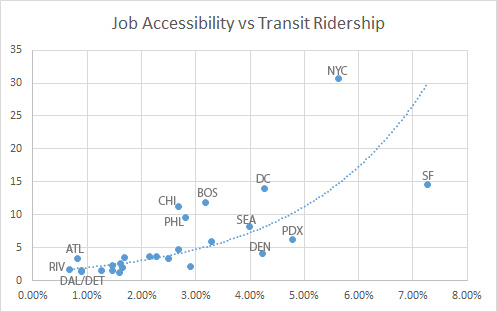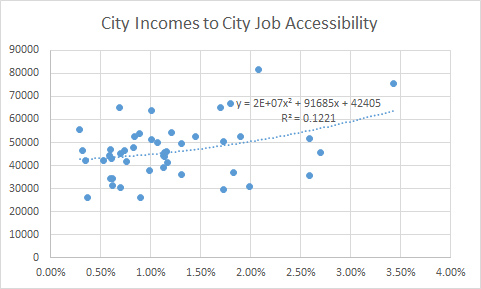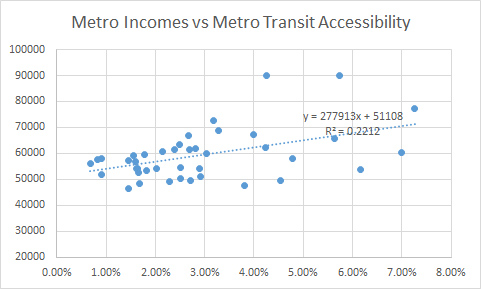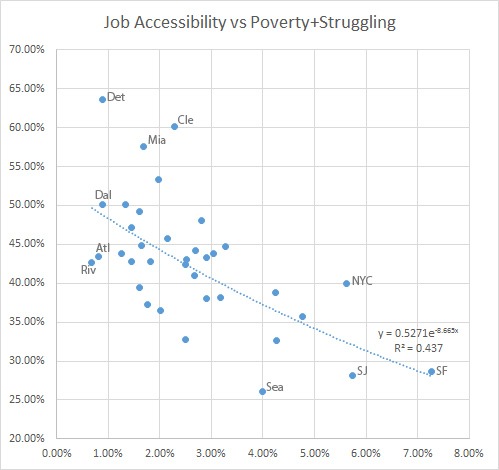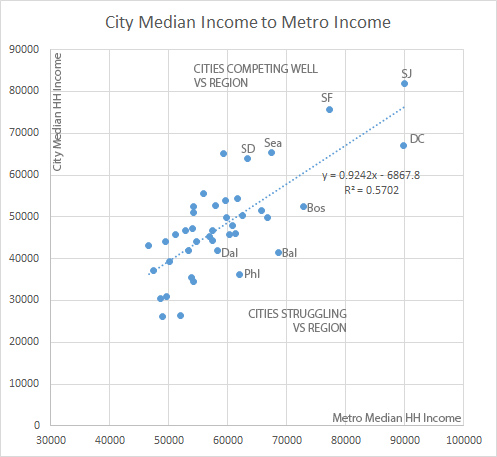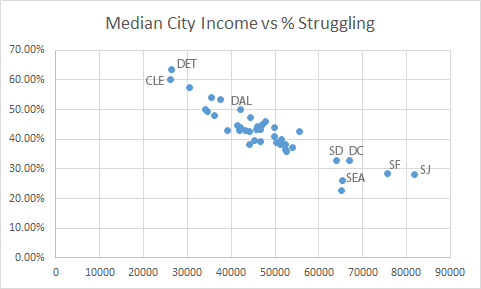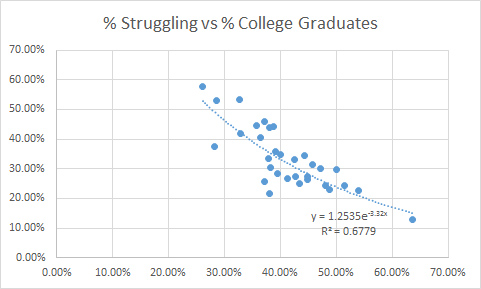There is plenty of chatter out there about helping the poor get to jobs by spending a few billion on toll roads. I’m here to tell you that just might not be a terribly wise strategy for anybody, the taxpayers nor the poor. Car dependence is particularly crippling on the poor since the average cost to own and operate a car is over $9,000/year. That is, if you need a car to get to a low paying job chances are half of the paycheck goes right out the door just in an attempt to make a paycheck. It’s a huge barrier to entry into the local economy.
Therefore, the ability to get to jobs via public transit is a critical component in the step ladder out of poverty. Fortunately, Professor David Levinson of the University of Minnesota has put together a study looking at how many local jobs are accessible via transit. In the study, Dallas-Fort Worth, despite having the 5th most jobs in the country, ranked 21st for total jobs accessible via transit.
However, I thought the data tended to skew towards bigger cities with more jobs. Small or medium-sized cities could have convenient transit despite having fewer jobs. They might have fewer jobs, but they also have fewer people. Of course, the fewer people and fewer jobs means lower tax base and less likelihood that the city can afford transit. But smaller cities can still build useful bus systems.
A key component in transit is the convenience and value of the trip. You aren’t going to ride transit if there is nothing to get to on the other side or is more of a hassle than other modes. I wanted to be able to compare the accessibility of jobs to rates of commuting via transit. Transit and jobs are there, but are people using it proportionally more or less than other systems in other cities?
Also, I wanted to explore the link between poverty and job/transit accessibility so I took all of the data tables I’ve assembled and mashed them up with the University of Minnesota study to begin looking a bit deeper at the role effective transit might have in reducing poverty.
From the Minnesota study I used both job availability for 30- and 40-minute commutes since the average commute across all cities tends to be between 25- and 35-minutes. Cities that skew longer in their commutes tend to make a bit more money. In other words, people will tolerate longer commutes if they’re making significantly more. So I wanted to focus on a similar commute duration where transit might be competitive with the average vehicular commute.
I also included metro area median household income, city median household income, the % poor + struggling (the census defines poor as below poverty threshold and struggling as living paycheck to paycheck, ie missing one paycheck would be catastrophic), as well as the rates of transit commuting for both metros and cities.
The following tables are these data mash-ups. First, is % of total area jobs accessible within a 40-minute commute vs. metropolitan transit commuting rate:
The upward curve shows that, yes, the more jobs available via transit does exponentially increase ridership. However, I wanted to do this one to use the trendline as a demarcation line for national median ratio between the theoretical accessibility of jobs via transit vs the actual utility of transit. The chart above shows that despite San Francisco having the greatest proportion of jobs available via transit, the metropolitan ridership is lower than it should be. Conversely, if a city falls above the line it has a rather useful transit system.
You’ll see that Riverside, CA, Atlanta, Dallas-Fort Worth, and Detroit have the lowest proportion of jobs available via transit, and thus, ridership is low. Dallas, despite having the longest light rail system in the country, is a statistical dead heat with Detroit.
So, does accessibility to jobs via transit have a relationship with incomes? Are transit friendly cities richer?
Meh. That’s difficult to discern because there are so many other variables involved such as education, technology, research institutions, government jobs, etc.
The data is slightly tighter on a metro scale, but it is still very faint.
But that’s not what we’re talking about here. The median household can better afford a car and driving to work. Less so for the poor and struggling. Let’s instead look at them.
Now we’re starting to see a stronger relationship. The cities that performed best in the Minnesota study also have the lowest rates of Poor and Struggling. The cities without many jobs accessible via transit also happen to have the greatest percentage of their population in poverty or close to it.
Some other tables:
Since I put both metro and city median household incomes I decided to compare the two to see which cities incomes might rival (or even exceed regional incomes). The west coast looks rather strong with Seattle, San Fran, San Jose, and San Diego all well above the line.
Above is a predictable relationship. The higher the median income in a city, the fewer percentage of the population that is struggling. Why might that be? Were the poor all displaced by the heathen gentrifiers? No. Higher median incomes in a city do truly lift all boats, requiring services, amenities, and the starter jobs providing the step ladder out of poverty.
Of course, it isn’t all down to transit. Education is still the most important factor. Invest in educating kids and in transit to help the poor get to jobs conveniently.


